Course: Oblivion is a fantastic piece of television, in large part because of how strange and surreal it feels. Like Distant Origin or Living Witness, it is an episode that demonstrates how effective Star Trek: Voyager can be, once it is willing to push itself beyond the template of familiar Star Trek storytelling. Course: Oblivion is a staggeringly weird piece of television, a bottle episode filmed with the primary cast on standing sets, but which only features the briefest of appearances from the regular characters.
More than that, Course: Oblivion effectively weaponises many of the long-standing weaknesses and clichés associated with the storytelling on Voyager. It is the very definition of a “reset” button episode, in that the events (and the ending) of the episode are both catastrophic in scale and utterly inconsequential in the larger scheme of things. In some ways, Course: Oblivion is the quintessential Voyager episode, distilling the destruction of Voyager and the death of Janeway into a tragedy with absolutely no repercussions.
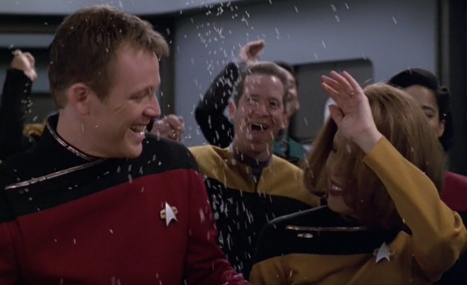
‘Til death do us…
Voyager could often feel generic and disconnected, a show without a unique identity. In many ways, Course: Oblivion is very unique to Voyager in that it builds those core ideas into the very fabric of the episode, constructing an episode that reflects Voyager‘s identity by channeling its identity crisis. As with various other episodes of the fifth season, like Night and Timeless, Course: Oblivion builds a meta-text around the anxieties rippling through Voyager at this point in the run.
However, Course: Oblivion is more than just an effective illustration of Voyager‘s storytelling tropes and unique sensibility. Course: Oblivion is also an episode that taps into a lot of the anxieties bleeding through the zeitgeist at the turn of the millennium. Voyager was undoubtedly a television of its time, and tended to reflect the existential paranoia of the nineties. Course: Oblivion is an episode about what it means to grapple with a person’s own unreality, to wrestle with an existence where meaning no longer exists, and everything is illusory.

“… well, that was quicker than expected.”
Even beyond those themes that anchor Course: Oblivion is the cultural landscape of the late nineties, the episode ties back into broader Star Trek themes. One of the great strengths of the Star Trek franchise is the freedom to use a science-fiction template to explore big questions. Course: Oblivion is an episode about what it means to face death, in a manner very distinct from the way that television usually treats death. The death in Course: Oblivion is not meaningful or epic or heroic. The death in Course: Oblivion is inevitable decay, a murmur in an infinite void.
The result is one of the most striking and effective episodes that Voyager ever produced, and easily the most ambitious episode of the fifth season as a whole.

Face off.
It is a running joke that Voyager loves to blow up its ship and kill its crew. Perhaps this is just down to advances in computer-generated technology, with image rendering allowing the production team to blow up the ship in new and interesting ways that simply would not have been feasible with a more convention model like that used to represent the Enterprise on Star Trek: The Next Generation or Star Trek: Deep Space Nine. Perhaps this is simply down to the shift towards broader blockbuster storytelling, with higher stakes and more involved action.
Whatever the reasons for these creative choices, Voyager is populated with stories in which the ship and the crew die horrible. Janeway (or a depiction of Janeway) dies no fewer than seventeen times over the course of Voyager: Time and Again, Deadlock, Coda, Before and After, Worst Case Scenario, Year of Hell, Part II, Living Witness, Timeless, Course: Oblivion, Relativity, Barge of the Dead, Tinker, Tenor, Doctor, Spy, Shattered and Endgame. This is to say nothing of cases where Janeway is killed and medically revived, like The Killing Game, Part I.

Melting his heart. And his face.
Voyager is a show obsessed with its own mortality, with the looming spectre of death and destruction always just around the corner. Of course, the grand irony is that these are characters on a weekly television show, and so they inevitably return the following week with no lasting damage done. In some ways, Voyager plays almost like a weird televisual purgatory for the Star Trek franchise, its characters trapped in a perpetual cycle of death and rebirth over which they have no control. No matter how brutally the writers might kill them, they inevitably return.
At the same time, most of these deaths are presented as somewhat heroic in nature. Janeway dies repeatedly in Coda, but eventually claws her way back to the land of the living. One of the Janeways in Deadlock blows up her ship so that her counterpart might survive. Janeway rams the ship into Annorax’s timeship at the climax of Year of Hell, Part II, effectively resetting the timeline and setting everything back to normal. Death is a big event and spectacle, something truly impressive in scope and consequence. At the very least, it is normally reversed.

Nice catch.
Course: Oblivion approaches the idea of death in a very different way. The death in Course: Oblivion is not epic or heroic. Instead, it is slow and creeping. The crew are confronted with their own mortality, made aware of the fact that they will all die. In Course: Oblivion, death gradually eats away at the crew. They are eroded and diminished. Decay sets in. At one point in the episode, the ship has been so weakened that “interstellar dust” poses a tangible risk to the ship and crew.
Course: Oblivion is a reminder that to dust (or puddles of “deuterium, hydrogen sulphate and dichromates”) must all return. Indeed, the show is bleakest in its final moments, the senior staff reduced to nobody by doppel!Kim and doppel!Seven. The crew build a “time capsule” that might in some way ensure a lasting legacy of their journey. That capsule is lost when the launch misfires. The crew detect Voyager in the distance, but are blown apart while trying to decelerate. The real crew continue on their way, oblivious to the near miss with their silver blood doppelgangers.

And the band played on.
Course: Oblivion is the work of writers Nick Sagan and Bryan Fuller, two of the younger writers on the Voyager staff. Bother Sagan and Fuller were working from a story idea by Fuller, and it is very easy to see how Course: Oblivion fits within the larger body of Fuller’s work. Writers tend to have pet themes and fascinations that play out across their work, ideas that bubble through their output regardless of genre or tone or style. Fuller is fascinated by the prospect of death, and the relationship that exists between life and death.
Fuller himself will openly acknowledge that he is engaged with the idea of death. “I had gone to a lot of funerals as a child, so I was more than just a little death-obsessed,” Fuller has offered by way of explanation for his interest in the theme. More profoundly, Fuller has contended, “I’ve never quite divorced the horror of death from the beauty of life.” This interest is reflected in his choice of subject matter and material. Fuller is very much engaged with horror and supernatural themes.

Everybody dies alone.
Fuller’s career includes projects like reboots of Friday the 13th and The Munsters. Even in projects that are not overtly horror stories about death, Fuller’s interest in the theme tends to play out. As Constance Grady notes in her discussion of Fuller’s work on American Gods:
The first series he created on his own, 2004’s Dead Like Me, doesn’t contain a romantic life/death pairing, but it is about a group of dead people helping usher the living to their preordained deaths, while simultaneously struggling to function as dead people in the living world. Fuller left Dead Like Me before its first season concluded, and the series’ focus quickly shifted, but its fundamental tension — the push and pull between life and death, constantly drawn to and repelled by each other — was one Fuller has continued to explore in his subsequent work.
The object of Fuller’s aesthetic interest is consistently death: death made charming and whimsical and romantic in Pushing Daisies, or death made seductive and demonic in Hannibal. At the heart of those two most recent stories is, put very simply, a living man who wants to f$!k death and feels weird about it.
It definitely makes sense. Notes Allison McCracken of Fuller’s filmography, “What binds Hannibal creator Bryan Fuller’s body of work is an acceptance of death as an inextricable part of life.” This plays out even in his lighter work.

Scarred tissue.
Much like fans can see a lot of Battlestar Galactica developing during Ronald D. Moore’s tenure on The Next Generation and Deep Space Nine, Bryan Fuller’s tenure on Deep Space Nine and Voyager is very informative of the writer that he would become. It is worth noting that his first two scripts for the franchise, The Darkness and the Light and Empok Nor, were both effectively grisly serial killer narratives.
To be fair, Voyager was too conservative a television show to let Fuller engage completely with his pet interests and themes. Nevertheless, they still bleed through. Fuller uses heavy stylised dream imagery in scripts like The Raven and Retrospect, which seem more visually experimental than many surrounding stories. Similarly, episodes like Mortal Coil and Barge of the Dead engage rather heavily with the question of what death means within the framework of the larger Star Trek universe.
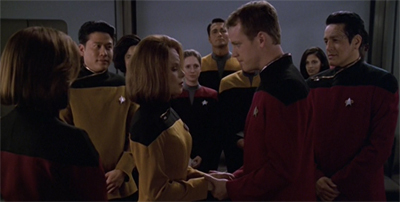
They vowed never to let it happen again.
Course: Oblivion is an episode that explores the complex relationship between life and death. The episode opens with a focus on life; doppel!Paris and doppel!Torres get married in the teaser, while doppel!Janeway’s introductory log reveals that a new child has been born on the ship. However, the rest of the episode features a slow and unstoppable march towards death. Meanwhile, the characters all try to make sense of their lives, grappling with what those lives actually mean and the question of whether they will find some way to live on.
In Course: Oblivion, death is presented as an entropic force. It wears away at people. In some ways, despite the fact that it does not feature any human (or even humanoid) characters, Course: Oblivion feels like one of the most grounded and honest portrayals of death in the larger Star Trek franchise. Death is an inevitability, it comes for everybody. In an existential sense, everybody is dying all the time; every second representing one step forward on that journey. Very few people get to die in a spectacular or heroic fashion, and everybody on some level knows that.

All goo things.
There is a profound sadness running through Course: Oblivion, an expression of a deep-set and long-standing existential crisis. Confronting the inevitability of death is perhaps the most profound existential crisis, as Stanislav Grof and Joan Halifax note in The Human Encounter With Death:
The shattering encounter with these critical aspects of the human experience and the deep realization of the vulnerability and impermanence of the human being as a biological creature have two important consequences. The first of these is a profound existential crisis that forces the individual to question seriously the meaning of existence and any values in life. One comes to realize through these experiences that no matter what one does in life, there is no escape from physical death; all human beings will have to leave this world bereft of everything that they have achieved or accumulated. This ontological crisis is usually associated with a crystallization of basic values. Worldly ambition, competitive drive, and craving for status, power, fame, prestige, and possessions tend to fade away when viewed against the background of the ending of each human drama in biological annihilation.
The looming threat of death provides a focus on what is important. How long can doppel!Janeway stick to her commitment to get the crew home, in the face of this inevitable death? Is doppel!Paris right to engage nihilism? Is doppel!Janeway right to refuse to take the lives of others to preserve her crew?
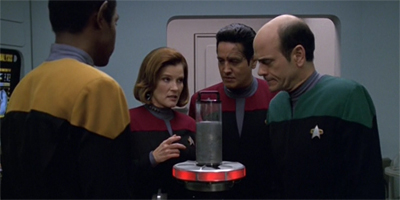
Janeway discovers what she is made of.
These are tough questions, and their answers suggesting interesting facets of the human experience. It could be argued that the destruction of doppel!Voyager at the end of the episode has no meaning, but it could also be argued that the way in which the crew responds to their impending death gives their lives something resembling purpose. The crew have no idea who they are at the start of Course: Oblivion, but they certainly find out by the end of the hour.
doppel!Janeway’s refusal to destroy an alien ship to ensure her survival is a gesture that has weight and importance, even if she is not the “real” version of Captain Kathryn Janeway. Just because her life ends with a whimper, and just because there will never be any record of her in any official documentation, it does not mean that her choices were wrong or lesser. The crew of doppel!Voyager might not have been able to forestall their deaths, but that does not invalidate their lives.
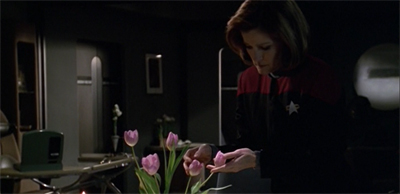
Hope flowers eternal.
Of course, this fear of death threaded through Course: Oblivion is wedded to another key existential anxiety. Course: Oblivion reveals quite early in the episode that the characters appearing on screen are not the “real” versions of the Voyager crew. Instead, they are the duplicates who were created at the very end of Demon, a highly forgettable late fourth season episode. These characters have never been to Earth. Instead, they are products of the so-called “silver blood.”
The crew are forced to confront their own unreality, that fact that they are not who they thought they were. “So you’re saying all our experiences before we were duplicated, none of it’s real?” asks doppel!Kim. doppel!Janeway responds, “I don’t pretend to understand it myself, Harry, but the way I choose to look at it is this. If everything about us was duplicated, that includes our memory engrams, the emotional centres of our brain. So if you feel something, remember something, believe something, I’m not about to tell you it’s not real.”

Morality is fluid.
I think it’s an episode people either love or hate. The ‘hate’ category seems to say, “Why do we follow a crew that isn’t even our regular crew?” and they feel cheated.
But it really is the story about the poignancy of Voyager’s journey. There’s something about trying really hard and not being quite able to achieve it, which is a reality to a lot of people. There are many achievements that we are able to accomplish. There are many more things that we don’t quite succeed at, and that doesn’t make them any less valid. It’s about a need to be remembered, a need to be recorded, and that’s the special tragedy about making a log, a kind of capsule – we know that the Demon crew dies. It’s about loss and remembering, death and grief.
In terms of how it got started, I wasn’t a particularly big fan of Demon either. But we sort of liked the idea of picking up the mimetic crew, and finding out whatever happened to them. And it was Bryan [Fuller] that came up with the story for it, and because Bryan and I had worked on Gravity and we had started writing together, I was brought in to work on that. It might be my favourite Voyager episode I did, either that or Relativity or In the Flesh, Gravity too.
Theoretically, Course: Oblivion is just as much of a “reset” episode as Time and Again or Deadlock or Year of Hell, Part II or Timeless.

That’s a whole new meaning to “mess” hall.
Voyager is populated with duplicates and copies of the original crew. There are any number of causes: alternate timeless like in Time and Again or Year of Hell, Part II; alternate futures like in Timeless or Shattered; holographic representations like in Worst Case Scenario or Author, Author; broken pasts like in Relativity or Fury; models created by other societies like in Distant Origin or Living Witness; impersonators and actors like in Muse or Live Fast and Prosper. However, it frequently seems like the galaxy is populated with alternate versions of the Voyager crew.
Of course, the other Star Trek shows have more than their fair share of duplicates and clones: Kirk’s transporter double in The Enemy Within, the mirror universe in Mirror, Mirror, Garth in Whom Gods Destroy, the alternate Datas in We’ll Always Have Paris, the future Picard in Time Squared, the cloned Rikers in Up the Long Ladder, the alternate reality in Yesterday’s Enterprise, the destroyed ships in Cause and Effect, the transporter double in Second Chances, the synthetic O’Brien in Whispers.
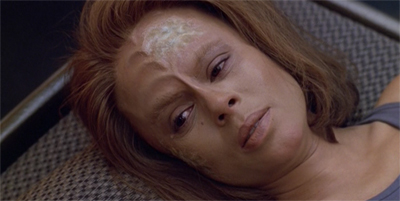
“Is my skin a bit blotchy?”
However, no other Star Trek show features these doppelgangers with the same level of intensity and frequency of Voyager. This is worth noting. The primary antagonists on Deep Space Nine are literal shapeshifters who employ a slave race of clones. Even allowing for this, Deep Space Nine does not feature nearly as many duplicates and stand-ins as Voyager. More than any other Star Trek show, Voyager is obsessed with the question of what is “real” and what is “unreal.” The show often seems uncertain of the answer.
Course: Oblivion is relatively unique in the grand scheme of things because it is an episode where the duplicates actually discuss their nature as doppelgangers of the regular cast. Most other Voyager episodes gloss over the existential horror of confronting unreality, but Course: Oblivion confronts the idea head-on. The silver blood replicas in the episode repeatedly and consciously grapple with the fact that their memories and their identities have all been fabricated.

No need to get bent out of shape.
“We are all duplicates,” doppel!Tuvok explains early in the episode. “None of us are real.” This is understandably an earth-shattering revelation. “I was born on Earth in Indiana,” insists doppel!Janeway. “I remember growing up there. I remember graduating from the Academy. I have no memory of being a copy.” The silver blood copies of the Voyager crew were so convincing that they effectively convinced themselves. doppel!Chakotay explains, “Eventually, we assumed their lives and set a course for Earth.”
Over the course of Course: Oblivion, everything that these characters assumed to be true is revealed to be false. It is a cover, an elaborate attempt to provide some sense of meaning or purpose to the lives of characters who effectively emerged full-formed from a puddle of weird silver goo. These aliens chose to believe that they were the Voyager crew because that provided them with a sense of context; these borrowed lives afforded them both a history and a future. However, Course: Oblivion finds them confronted by the fact that everything that they hold dear is a lie.

To be fair, the catsuit probably makes a bit more sense in this context.
This is arguably the second big existential crisis nestled at the heart of Course: Oblivion. The way in which the episode grapples with death is perhaps the single most fundamental human crisis, the realisation that life is impermanent and that every life ends in death. The way in which the episode wrestles with the question of reality and identity is another very human crisis, but one that feels more particularly rooted in the context of the nineties.
Voyager is very engaged with this question of what is real and what is not. Repeatedly over the course of the show, characters tend to find their sense of reality distorted and bent. The EMH and Seven of Nine both experience repeated nervous breakdowns over the course of the show, struggling to separate reality from unreality; the EMH in Projections and Latent Image, Seven of Nine in One, Infinite Regress and The Voyager Conspiracy. This crisis of reality reflected a broader anxiety rippling through nineties pop consciousness.
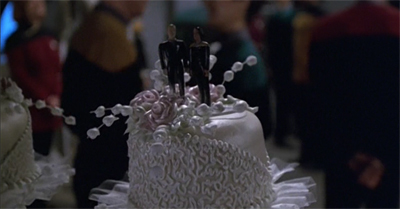
Having their cake and eating it too.
Notably, Voyager features the recurring suggestion that life inside the holodeck is no less real or substantial than life beyond. This is most notable with the character of the EMH, the first holographic primary character to appear in the franchise. Early episodes like Eye of the Needle touch upon the idea that the EMH is no less real than his crew members, an idea reinforced in later episodes. In The Swarm, he wrestles with an error in his programme that is indistinguishable from neurological decay in a human being. In Real Life, he starts a family.
Aliens repeatedly confuse the holodeck for the “real” starship. In Heroes and Demons, an alien preys on the crew inside the holodeck, but never strays beyond those four walls. In Bride of Chaotica!, alien explorers accept Paris’ Captain Proton! holoprogramme as reality, and insist that the flesh-and-blood crewmembers cannot possibly be reals. Even in Tinker, Tenor, Doctor, Spy, a bunch of aliens confuse the EMH’s holographic fantasies of Voyager from the real ship.

Maps to the stars.
As the philosopher Fredric Jameson argues in The Cultural Logic of Late Capitalism, the end of the twentieth century confronted the public with countless replicas and duplicates that tended to make it difficult for any observer to determine what (if anything) was truly real:
The ultimate contemporary fetishization of the human body, however, takes a very different direction in the statues of Duane Hanson: what I have already called the simulacrum, whose peculiar function lies in what Sartre would have called the derealization of the whole surrounding world of everyday reality. Your moment of doubt and hesitation as to the breath and warmth of these polyester figures, in other words, tends to return upon the real human beings moving about you in the museum and to transform them also for the briefest instant into so many dead and flesh-colored simulacra in their own right. The world thereby momentarilv loses its depth and threatens to become a glossy skin, a stereoscopic illusion, a rush of filmic images without density. But is this now a terrifying or an exhilarating experience?
Art and commerce were dominated with facsimiles of authenticity. Impoverished artists sold their work as “genuine fakes”, marketing perfect replicas of beloved and iconic artwork that was indistinguishable from the original. CGI allowed for even more lifelike recreations of real people. Oliver Reed could finish working on Gladiator, despite dying during production.

“I’m sorry, but it just doesn’t scan.”
The last decade of the twentieth century seemed caught up in this crisis of authenticity. It occasionally felt like a möbius strip. When Coca-Cola branded their product as “the real thing”, the band U2 responded with a gleefully ironic salute in Even Better Than the Real Thing; Richard Branson then reportedly tried to buy the rights to the song to use in a series of commercials for Virgin Cola. Ingrid Sischy, fashion editor of The New Yorker, argued at the time that “what we’re seeing is a collective attraction to something that seems to symbolize, in quotes, reality.”
The nineties found people confronted with the challenges of simulated reality and perfect recreation. Scientists generated international headlines by successfully cloning a sheep, as the mapping of the mapping of the human genome broken human identity down into its smallest tangible elements. Toys like Furby (and even tamagotchis) offered simulations of life that were designed to placate and fool children. Scientists destroyed photons and perfectly recreated them three feet away. In that context, what is real?

A chilling conclusion.
This unreality consciously crept into every facet of everyday life, even something as seemingly innocuous as architecture. As Ada Louise Huxtable contended in The Unreal America, a lot of design work in major cities during the nineties was designed to approximate the appearance of history by evoking the popular memory rather than preserving what is real and authentic:
In Washington, D.C., the art of historical camouflage is being given a special twist: the nation’s capital is being Disneyfied with whole streets of carefully amputated eighteenth- and nineteenth-century facades, cunningly retained and prettily restored as literal false fronts for outsize new buildings erected directly behind them. These “preserved” streetscapes look as if they have been wheeled in, like stage flats; one half expects appropriately costumed performers to jump out and sing. Or at least walk around, shake hands, and pose for pictures with the tourists, a la Mickey and Goofy. Surely a dubious-achievement award should go to this insane compromise that succeeds in making fakes out of something real.
It is a very jarring disconnect, and it is no wonder that people came to feel that existential unease. If the “preserved” buildings are not real, if a child’s beloved “pet” is not real, if “Oliver Reed” in that movie is not real, that that “sheep” is not real… then what is “real”? It is a question without an easy answer.

Not a patch on the real Janeway.
Understandably, that existential angst rippled through the popular consciousness. Course: Oblivion was written in the broadcast just as that anxiety build to critical mass. It was released just over a year after Dark City, less than a year following The Truman Show, four weeks before The Matrix, just over a month before eXistenz, a couple of months before The Thirteenth Floor and in the television season immediate prior to the launch of Harsh Realm.
The duplicate crew in Course: Oblivion is wrestling with more concrete and absolute iterations of the questions that tend to simmer away at the back of the public consciousness: the inevitability of death and the uncertainty of reality. The fifth season of Voyager was aired as the world hurtled towards the new millennium, that anxiety plays out across the entire season and even across the rest of the show. Episodes like 11:59 touch on this millennial panic in a less subtle manner.

Silver (blood) lining.
At the same time, Course: Oblivion plays almost like a commentary on Voyager itself. Since Brannon Braga took over the running of the series, Voyager has been gripped by an existential crisis as it attempts to figure out its identity and its purpose. After Jeri Taylor departed the show with Hope and Fear, Janeway effectively locked herself away from the crew to wrestle with depression and to figure out where it went wrong. Course: Oblivion is just the most obvious counterpart to the real Voyager in a season full of them; the colony ship in The Disease, the Equinox in Equinox, Part I.
Episodes like Course: Oblivion, The Disease an Equinox, Part I effectively allow audiences a glimpse of alternative versions of Voyager. They tease viewers with a glimpse of how things might have been different. The Disease features a ship on a long journey that has been allowed the opportunity to change and grow, to develop its own culture and identity. Equinox, Part I features a Starfleet ship that embraced more situational ethics, committing to the character journey suggested by Janeway’s decisions in episodes like Nothing Human or Latent Image.

The image of a thing might just be a thing…
Course: Oblivion does something similar, albeit more subtle. Course: Oblivion quite pointedly allows for more character development and growth than is normally permitted on Voyager. As Nick Sagan acknowledged, one of the more fun aspects of the episode is the way that it allowed the writers to do things that they could not otherwise do:
One of the great things about Course: Oblivion is that you could do whatever you wanted to do, because they’re not the real crew, so it’s one of those wonderful “What if?” episodes. And one of the things that I liked about the episode is that here’s a couple and they’ve been trying to get together for the longest time and they’re not able to achieve it – but the mimetics are able to achieve it.
There’s something about that crew that I like in many ways more than the real crew. They’re trying to be the best that they can possibly be, and it’s just unfortunate that they’re very good at what they are, but they’re not real.
Course: Oblivion opens with the wedding of doppel!Paris and doppel!Torres. Their counterparts would not get married until Drive, early in the show’s final season. doppel!Janeway’s opening log reveals that the crew have begun having babies together; the writers did not allow the flesh-and-blood crew to have babies conceived on the ship until Lineage, another final season episode.

“Copy that.”
The characters within Course: Oblivion seem to acknowledge that these events are very much outside the norm, that they do not fit with the very static pace of life on the ship in general. “I never thought I’d see the day,” the doppel!EMH muses. “We’ve had a lot to celebrate lately,” concedes doppel!Janeway in her opening log. While Course: Oblivion is very much an episode about decay and death, it is also an episode about life. It could reasonably be argued that these characters live more in the space of a single episode than their counterparts do all season.
In some respects, Course: Oblivion also feels like an example of self-criticism from Voyager, with Fuller and Sagan using the script to make a commentary on Voyager itself. The use of the silver blood duplicates in Course: Oblivion allows the writers to step around some of the more absurd restrictions on characterisation and behaviour on Voyager. Most notably, the crew are allowed to argue with one another over the course of the episode. doppel!Chakotay stands up to doppel!Janeway in a way that his counterpart hasn’t since Scorpion, Part I and Scorpion, Part II.
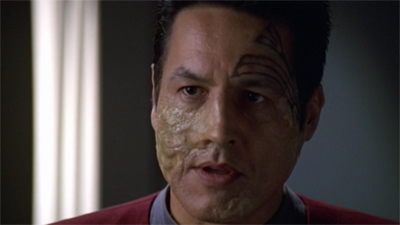
“Look, at least my tattoo still looks cool.”
After doppel!Torres dies, doppel!Paris actively challenges doppel!Janeway, in a manner that feels organic and earned. After all, what authority does doppel!Janeway have. However, this tension underscores one of the key recurring problems with Voyager as a television show. Why are the crew so accepting of the chain of command? Why are the crew so unwilling to argue their points? What authority does the real Janeway have over this crew in these circumstances? These are interesting questions, but Voyager largely sidesteps them after Caretaker.
Even more than the character dynamics, the basic premise of (and ending to) the episode challenge Voyager. This is an episode quite pointedly built on stock Voyager tropes; there are duplicates, everything is unreal, the crew die, the ship explodes. However, Course: Oblivion uses those stock elements to tell a genuinely moving and affecting story. Course: Oblivion takes what have traditionally been blockbuster trappings and plays them as horrific tragedy.

Harry on, regardless.
After all, this is a crew that effectively realises the horror of starring in Voyager. These are characters who understand that their entire reality is a lie, that they are just broad concepts fashioned into the shape of recognisable characters. More than that, these characters seem to realise the folly of their adventure. The ending of Course: Oblivion is bleak and nihilistic, but it really doesn’t feel so far removed from the ending of any other episode of the show.
Fans might complain that the ending of Course: Oblivion is both mean and meaningless, but when was the last time that any episode of Voyager had a meaningful ending? Sure, those other episodes might exist “in continuity” with one another, but does that mean anything if that continuity is never acknowledged or explored? Characters on Voyager go through horrible events week-after-week, but those traumas never have any lingering consequences.
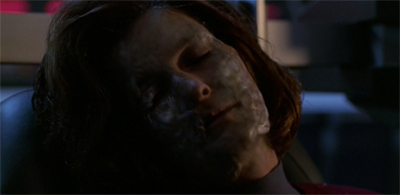
Janeway will sleep when she is dead.
Janeway grappled with depression in Night, but what about the lasting consequences of wrestling with such an illness? Torres was suicidal and depressive in Extreme Risk, but she snapped out of it pretty quickly and never mentioned it again. Chakotay was abducted and turned into a trained killing machine in Nemesis, but has never demonstrated any lasting psychological scars. Tuvok struggled with his emotions in Gravity, but was back to normal the next week. Paris was demoted in Thirty Days, but remains part of the senior staff.
Course: Oblivion goes just a little bit further than any of these endings by actually blowing up doppel!Voyager and its crew, but this just seems like that same episodic structure taken to its logical extreme. After all, the version of Kim who appears on the bridge at the very end of the episode is not the real Harry Kim at all, he is the replica version from Deadlock. However, that simple reality is never acknowledged or explored, the existential weight of that knowledge is never unpacked.

“Or maybe he is the real Kim and it’s the entire other Voyager that’s fake. I don’t know, I’m tired.”
Course: Oblivion seems to actively tease the audience. As Kenneth Biller explained to Cinefantastique, the episode is structured in such a way as to invite interesting questions:
This mimetic life form that existed on that planet could re-create anything. It would re-create a ship that had an atmosphere in which these people could live. We didn’t want to answer a lot of questions like, how long has that ship been out there? Some of the episodes that we saw earlier in the season, was it that crew? Or was it the real crew? It’s kind of intriguing to think about.
In theory, any number of episodes between Demon and Course: Oblivion might have featured the doppel!Voyager and its crew, with the audience none-the-wiser.
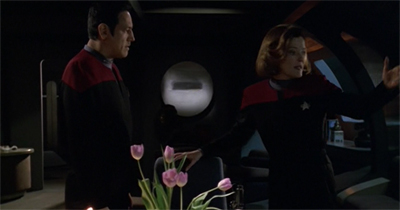
A duplicate of a rose, by any other name…
In reality, Course: Oblivion is written in such a way as to consciously downplay this notion. Most obviously, doppel!Paris has not been demoted to ensign. As such, at the very least, every episode from Thirty Days to Course: Oblivion must logically have featured the real crew. More to the point, when doppel!Tuvok and doppel!Chakotay begin working backwards through the mission logs to determine the cause of the decay, they reference quite a few unfamiliar aliens; the Kmada and the N’Kree.
More than that, the episode is quite cleverly constructed. Sagan and Fuller make sure to cover most of their bases. The development of the new warp drive, and the implied course correction, provide a nice justification for why neither Voyager has overlapped with the other. Species like the Devore or the Malon would certainly be very confused if the two versions of Voyager had charted the exact same course through the Delta Quadrant.
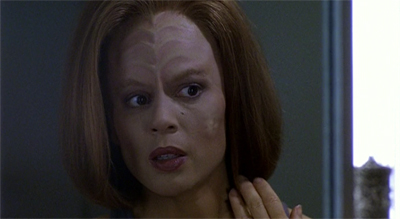
Torres is not feeling herself lately.
Plotwise, the enhancements to the warp core also provide a number of other very clever and subtle plot justifications. They provide a very clear red herring during the first act, a possible explanation for what is happening that doesn’t immediately reveal that doppel!Voyager is not the real ship. They also explain how doppel!Voyager was able to both overtake the regular Voyager and to intersect it on the return journey. (Of course, that climactic near-miss is still a huge plot contrivance that glosses over how big space actually is.)
More than that, even the clever revealing detail that doppel!Paris was never demoted to ensign plays as a wry commentary on audience expectations with regard to Voyager. Clued-in and eagle-eyed audience members might instantly notice that something is amiss, but how many would chalk that up to a simple continuity error? The script to Course: Oblivion seems to play on that expectation, as if suggesting that such continuity gaffes were more acceptable after the clumsy rewriting of history in Dark Frontier, Part I and Dark Frontier, Part II.

In lieu(tenant) of an explanation…
That said, Course: Oblivion seems to tap into an even more fundamental anxiety about Voyager and its place in the larger Star Trek canon. The reveal that the crew are all duplicates and imperfect replicas speaks to a deep-seated uncertainty within Voyager itself. Voyager has always existed in the shadow of other Star Trek shows, often overshadowed by the success and the expectations of The Next Generation.
It could reasonably be argued that Voyager is as much an imperfect replica of The Next Generation as doppel!Voyager is an imperfect replica of Voyager. Voyager certainly has an identity crisis with regards to The Next Generation, something that plays out across the run of the show in various ways. Timeless was supposed to be the one hundredth episode of Voyager, but it was overshadowed by a cameo from LeVar Burton flying a Galaxy-class ship. Dark Frontier, Part I and Dark Frontier, Part II represented a straight-up reiteration of Star Trek: First Contact.
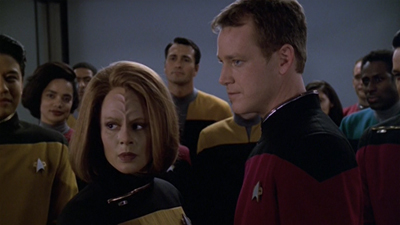
Un-bride-led enthusiasm.
Five years into its run, Voyager has struggled to define a unique identity for itself. In some ways, this lack of a distinct identity has become a makeshift identity. The writing staff would occasionally try to push beyond the confines and expectations imposed on Voyager to follow the template established by The Next Generation, but time and again those writers would be forced to compromise their artistic visions and to beat their stories into a safer shape.
Brannon Braga envisaged Year of Hell, Part I and The Year of Hell, Part II as a season arc; he was allowed to write the story as a two-parter. Michael Taylor’s pitches for Once Upon a Time and The Fight were arguably as ambitious as his work on The Visitor, but they were quickly watered down into very bland and forgettable episodes of television. Voyager could never be itself. It could only ever be an ineffectual copy of a more illustrious predecessor.

Structural integrity, eh?
There is more to it than that. Course: Oblivion arrives at a point where the Star Trek franchise is clearly in decline and where the future was no longer assured. The thirtieth anniversary had been a massive success, but that was more than two years ago. Ratings were in a slow and steady decline. Star Trek: Insurrection had opened to unkind reviews and mediocre box office. Deep Space Nine was coming to an end after seven years, and Paramount had not expressed any interest in producing a new Star Trek series to fill that potential gap in the market.
Voyager would sound find itself the sole standard bearer of the Star Trek brand, the only example of the franchise in active production. For the first time in seven years, there would only be on Star Trek series on the air, and it would be Voyager. This understandably put a lot of pressure on Voyager. Given the show’s difficulty asserting and defining its own identity, what chance did it have of carrying a thirty-odd year legacy? Voyager might have easily felt like an imposter.
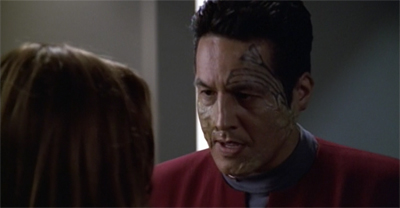
“I know when we’re liq’ed.”
To make matters worse, the vultures were beginning to circle, and the knives were out for the Star Trek franchise. Journalists openly queried whether the franchise was in a state of decline and decay. As Robert Wilonsky argued, part of the issue was saturation of the market by Star Trek clones:
The death, or at least the slowing, of the franchise was perhaps inevitable all these years later — especially since Next Generation and DS9 still appear in daily syndication alongside now-daily Voyager reruns. (It’s hard to tell the old episodes from the new, since they all look so much alike.) And the Sci-Fi Network, home to several Trek-alikes that have begun to diminish the franchise’s impact, reruns The Original Series every afternoon.
Star Trek, quite simply, breeds like Tribbles.
“When Star Trek was like an island unto itself, during those years when it was in reruns, there was a specialness to it,” says Tracy Torme, a writer on Next Generation during its first two seasons and a friend of Roddenberry’s during the Star Trek creator’s final days. “It ran a couple of years, there had been a couple of movies, but there was still a uniqueness to it. The danger you run into when you have as many spinoffs and so many episodes to come down the pike, it loses its special quality. You can’t help it. There’s so much more to watch. That could be part of the problem — it’s the over-saturation.”
Course: Oblivion captures this irony beautifully. Voyager is undoubtedly a more perfect replica of The Next Generation than any of the other high-profile science-fiction shows that were flooding the airwaves during the nineties and crowding out Star Trek, but it still felt like a copy and imitation rather than the real deal.

“So, today in Star Trek branding, we have some interesting items for you.”
Course: Oblivion seems to capture the increasingly real anxiety about the future of the Star Trek franchise, the creeping fear that the institution is trapped in a state of decay and erosion. “Every bulkhead and conduit from deck one to fifteen show signs of molecular de-cohesion,” reports doppel!Tuvok. doppel!Neelix agrees, “Even food from the replicator shows signs of decay.” There is a sense that entropy is at work, the long slow heat-death of Star Trek.
Course: Oblivion suggests that this decay is self-perpetuating, and that the Star Trek franchise might already be dead in the water even though it would limp on for another six seasons. “We’re going to have to beat this problem,” doppel!Janeway assures the crew, “and for now that means conserving energy, running the ship in grey mode, cutting crew shifts in half. The less you exert yourselves, the slower the cellular decay.” As the Star Trek franchise grapples with its decline, it slows down. It becomes less adventurous. It stops trying new things.

Terror, tubed.
There is something deeply cynical and nihilistic at the heart of Course: Oblivion, suggesting that the rot has taken root and that it cannot be dispelled. Course: Oblivion suggests that the decay spread so far sand so deep that best that can done is to slow the spread. In some respects, the warped and decayed forms of the familiar crew towards the climax of the episode foreshadow the looming end of the Rick Berman era, the idea that the Star Trek franchise would waste away in full view of fandom.
The second season of Star Trek: Enterprise is populated with the rotten and misshapen forms of familiar stories eroded by time, classic Star Trek played by an exhausted cover band; The Communicator is A Piece of the Action, Dawn is Darmok, Vanishing Point is Realm of Fear, Precious Cargo is The Perfect Mate, The Crossing is Return to Tomorrow or Power Play, The Breach is Jetrel. More than that, Star Trek: Nemesis wastes Tom Hardy as a decaying clone of Jean-Luc Picard, in a plot that blatantly rips of Star Trek II: The Wrath of Khan.
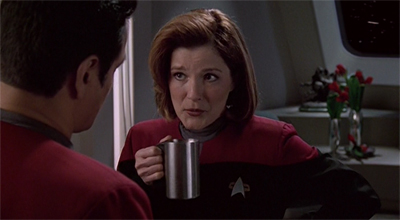
“Wait, you’re telling me the second season of Enterprise even ripped off a Voyager episode?”
Course: Oblivion is the rare episode of Voyager that seems perfectly aware of itself and its context, something that speaks both to the broader human condition and to the production realities of the show. Course: Oblivion is a remarkable piece of work. One of the great ironies of Voyager is that so many of its truly great episodes feature so little of the crew and the ship itself.
Filed under: Voyager | Tagged: anxiety, course: oblivion, existential crisis, identity crisis, millennium, reality, unreality, voyager |




















Great review! I had skipped this episode since it seemed like a tired VOY trope that I had seen before, but now you’ve sparked my interest in it.
Give it a go. I mean, it is exactly what it appears to be, but I genuinely think it’s a fascinating exploration of Voyager and that it fits in the context of the nineties.
Is this the real life? Is this just fantasy? Caught in the chronitons, no escape from anamolies
Funny you review this on it heels on twin peaks ending, which also had lookalikes melting into metal.
* on the heels of
I have yet to watch Twin Peaks, but somehow I suspect their execution might have been better and bolder.
Ah yes, this episode. I agree it’s all very clever but I found it all crushingly depressing and, yes, mean spirited. To be fair though it isn’t actually morally offensive like it’s relentlessly bloodthirsty contemporary ‘The Matrix’.
I don’t know. I think there’s something reassuring in Janeway’s refusal not to take lives to extend her own, even in the face of annihilation.
This episode is unique for its meta-commentary on the nature of Voyager, and Voyager’s approach to story telling and character. It’s also a bit of a nihilistic bore. We’ve seen this plot before, just not so refined down to a pure form. I have less of an issue with the supposedly depressing nature of the show than I do with the fact that was have to sit through 40 minutes of drama that we don’t really care about – much like other reset episodes. We’re forced to live through Paris’ grief at Torres’ death – yawn. Janeway dies again. Great. It’s little wonder that Sopranos and other shows came at this time, giving death a real weight in a way.
Course:Oblivion seems to channel Terminator 2 more than the Matrix. Grey goo. The Jameson quote was apt. We live in a world of replication.
I have mixed feelings about this episode. It’s kind of ambitious, but also kind of a middle-finger to the viewers who want some sort of meaning to the series.